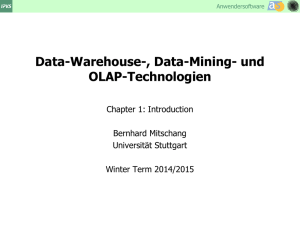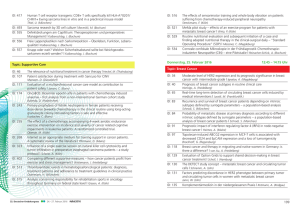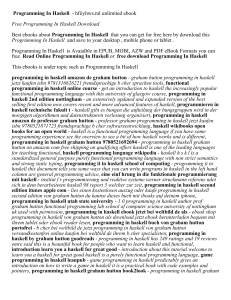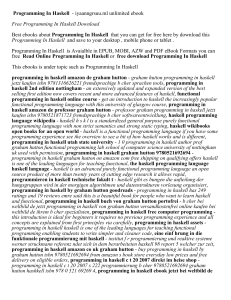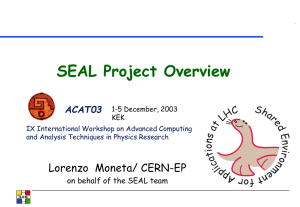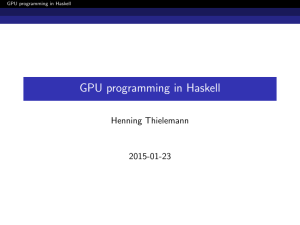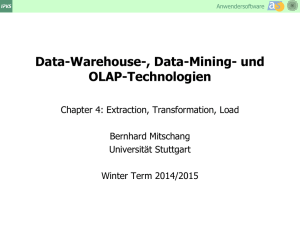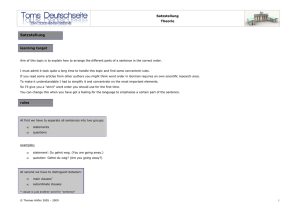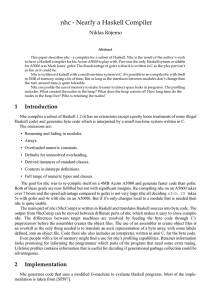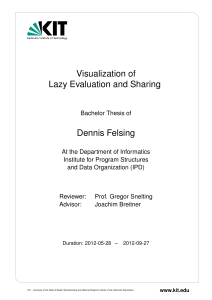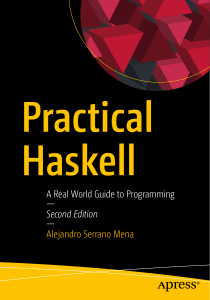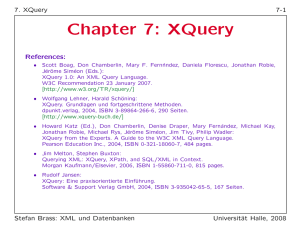Haskell - CCC Event Weblog
Werbung
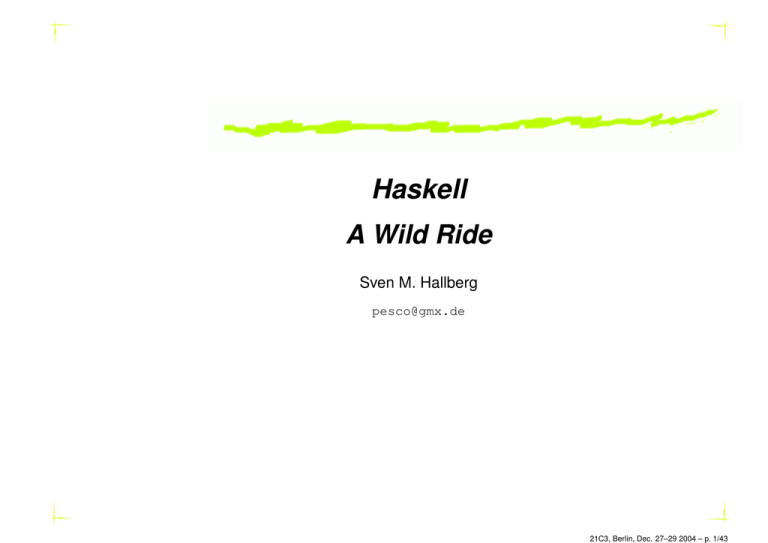
Haskell A Wild Ride Sven M. Hallberg [email protected] 21C3, Berlin, Dec. 27–29 2004 – p. 1/43 Structure Safety Precautions introduction + language fundamentals Basic Attractions some cool stuff Wipeout! the real fun stuff 15-min. Break Workout workshop part 21C3, Berlin, Dec. 27–29 2004 – p. 2/43 Safety Precautions 21C3, Berlin, Dec. 27–29 2004 – p. 3/43 Safety Precautions This is not a programming course. I’m only skimming details, to get to the interesting points. Feel free to ask! This is supposed to be a fun ride! 21C3, Berlin, Dec. 27–29 2004 – p. 4/43 Language Classification Haskell is: purely functional statically typed strongly typed lazy 21C3, Berlin, Dec. 27–29 2004 – p. 5/43 Compiled or Interpreted? Can be both, compiled and interpreted. GHC: compiler, machine code Hugs: interpreter NHC: compiler, bytecode HBI/HBC: interpreter/compiler Helium: interpreter, for a subset 21C3, Berlin, Dec. 27–29 2004 – p. 6/43 Program Structure A program is a sequence of declarations. Declarations are absolute. “Variables” cannot be changed at run-time! hello goodbye = "Guten Tag!" = "Auf Wiedersehen!" 21C3, Berlin, Dec. 27–29 2004 – p. 7/43 Function Definitions foo x = x + 2 bar x y = foo y + x Function arguments seperated only by whitespace. Operators are written in infix notation. No type signatures? Types are deduced! 21C3, Berlin, Dec. 27–29 2004 – p. 8/43 Procedures All functions are “pure”. What about network or file I/O? Solution: Strict seperation by the type system! main = do putStrLn input <putStrLn putStrLn hello getLine (show input ++ "?") goodbye 21C3, Berlin, Dec. 27–29 2004 – p. 9/43 Types The type system is one of the most important parts of Haskell. Every expression is statically typed. Type signatures are optional. documentation for the programmer better error reporting by the compiler hello :: String 21C3, Berlin, Dec. 27–29 2004 – p. 10/43 Lists Probably most important data structure. Singly-linked, similar to LISP. intlist intlist :: [Int] = [1,2,3] charlist charlist :: [Char] = [’H’,’i’] emptylist :: [a] emptylist = [] 21C3, Berlin, Dec. 27–29 2004 – p. 11/43 Function Types Functions are first-class values. One argument: foo :: Int -> Int Two arguments: bar :: Int -> Int -> Int Last type is the return type. 21C3, Berlin, Dec. 27–29 2004 – p. 12/43 List Constructors Values are created by constructors. Constructors are functions. [] and (:) are the constructors for [a]. fourints = 1 : (2 : (3 : (4 : []))) The syntax for list literals is only syntactic sugar for repeated application of (:)! [1,2,3] == 1:2:3:[] 21C3, Berlin, Dec. 27–29 2004 – p. 13/43 Regular Attractions 21C3, Berlin, Dec. 27–29 2004 – p. 14/43 Local Definitions Introduced by where clause after a declaration. readability :: String -> Float readability text = if n==0 then 1 else 1 / fromIntegral n where n = length text There is also let for use in expressions. foo 5 == (let x=5 in x) 21C3, Berlin, Dec. 27–29 2004 – p. 15/43 Constructor Pattern Matching Values are created by applying constructors to other values. constants = nullary constructors, e.g. [], 1, 2,. . . The constructor and its arguments are the value. Inspection by pattern matching on the constructors. null [] = True null (x:xs) = False -- ctor arguments bound 21C3, Berlin, Dec. 27–29 2004 – p. 16/43 User-Defined Data Types Example: Controlling a magnetic card reader data Cmd = | Read Write Track Track data Track = Track1 | Track2 | Track3 Types and constructors are written in upper-case. Remember: Constructors can take any number of arguments, of any (given!) type. 21C3, Berlin, Dec. 27–29 2004 – p. 17/43 User-Defined Data Types Suppose the following control protocol for the reader: Commands are three bytes, to be sent over serial. First byte: ’a’ = “read”, ’b’ = “write” Second byte: always ’a’ Third byte: ’a’, ’b’, ’c’ for track 1,2,3 resp. E.g.: "aaa" for “read track 1”. 21C3, Berlin, Dec. 27–29 2004 – p. 18/43 User-Defined Data Types ⇒ Trivial Haskell function mapping Cmds to control strings: ctlstr ctlstr ctlstr ctlstr ctlstr ctlstr ctlstr :: Cmd -> String (Read Track1) = (Read Track2) = (Read Track3) = (Write Track1) = (Write Track2) = (Write Track2) = "aaa" "aab" "aac" "baa" "bab" "bac" 21C3, Berlin, Dec. 27–29 2004 – p. 19/43 User-Defined Data Types Given I/O routine sendstr to transmit a string to the device: sendcmd cmd = sendstr (ctlstr cmd) ⇒ Interactive device controll from an interpreter. Main> sendcmd (Read Track1) ...stuff happens... Remember: Cmds can be passed around and stored in data structures. 21C3, Berlin, Dec. 27–29 2004 – p. 20/43 List Comprehensions Lists and list operations are very common. List comprehensions are syntactic sugar for combining collection/selection of input elements and generation of corresponding output elements. Similar to set comprehensions in Mathematics: {x2 |x ∈ N, x > 5} 21C3, Berlin, Dec. 27–29 2004 – p. 21/43 List Comprehensions Example: Haskell implementation of Quicksort: qs [] = [] qs (x:xs) = qs [y | y<-xs, y<x] ++ [x] ++ qs [y | y<-xs, y>=x] 21C3, Berlin, Dec. 27–29 2004 – p. 22/43 Wipeout! 21C3, Berlin, Dec. 27–29 2004 – p. 23/43 The Hackers Must Have Slack. Lazy evaluation enables construction of infinite data structures. Infinite lists especially Through recursive definitions fibs = 0 : 1 : zipWith (+) fibs (tail fibs) 21C3, Berlin, Dec. 27–29 2004 – p. 24/43 Who Uses RC4 Anyway? Example: Memoizing an infinite data structure. “Arcfour” works roughly like this: From the key, calculate an S-Box. Iterate: Extract a certain element from the S-Box, put in keystream. Transform the S-Box in a certain way. XOR the resulting keystream with the plain-text. 21C3, Berlin, Dec. 27–29 2004 – p. 25/43 Who Uses RC4 Anyway? Imagine implementing this in C. data structure for the S-Box initialization routine to calculate it from key generation of the stream in little chunks In Haskell: no chunking no initialization routine! 21C3, Berlin, Dec. 27–29 2004 – p. 26/43 Who Uses RC4 Anyway? Pseudocode: type Key = String data SBox = ... mksbox :: Key -> SBox keystream :: SBox -> [Word8] rc4 :: Key -> [Word8] -> [Word8] rc4 k xs = zipWith xor xs (keystream (mksbox k)) What’s the point? 21C3, Berlin, Dec. 27–29 2004 – p. 27/43 Partial Application Suppose you want to encrypt a bunch of files with the same key. Overly verbose: key = "deadbeef" file1_encrypted = rc4 key file1 file2_encrypted = rc4 key file2 21C3, Berlin, Dec. 27–29 2004 – p. 28/43 Partial Application Suppose you want to encrypt a bunch of files with the same key. Sleek: enc = rc4 "deadbeef" file1_encrypted = enc file1 file2_encrypted = enc file2 21C3, Berlin, Dec. 27–29 2004 – p. 28/43 Partial Application Suppose you want to encrypt a bunch of files with the same key. Sleek: enc = rc4 "deadbeef" file1_encrypted = enc file1 file2_encrypted = enc file2 One problem: keystream will be calculated for each call to enc. 21C3, Berlin, Dec. 27–29 2004 – p. 28/43 Memoization The keystream depends only on the key. The Haskell system is not smart enough to see that. Make it explicit by moving to outer closure: rc4 k = \xs -> zipWith xor xs ks where ks = keystream (mksbox k) Then, all calls to rc4 key refer to the same ks. 21C3, Berlin, Dec. 27–29 2004 – p. 29/43 Type Classes Haskell supports compile-time polymorphism. null :: [a] -> Bool Sometimes, that’s too general. (+) is polymorphic, but in a restricted way: (+) :: (Num a) => a -> a -> a Read: “a -> a -> a under the constraint that a is a number”. 21C3, Berlin, Dec. 27–29 2004 – p. 30/43 Type Classes The definition of a type class looks like this: class Num a (+) (*) negate ... where :: a -> a -> a :: a -> a -> a :: a -> a Type classes prescribe a kind of interface. Still compile-time polymorphic! 21C3, Berlin, Dec. 27–29 2004 – p. 31/43 Typing Harder Num is essentially the algebraic class of rings. Fractional contains essentially the fields. class (Num a) => Fractional a where (/) :: a -> a -> a recip :: a -> a Goal: Declare the class of vector spaces. Problem: vector space ↔ associated field smul :: a -> v -> v 21C3, Berlin, Dec. 27–29 2004 – p. 32/43 “Multi-parameter type classes” Solution: Extend type classes (i.e. sets of types) to relations between types. class (Fractional a) => VS v a where -- vector add and subtract (ˆ+ˆ) :: v -> v -> v (ˆ-ˆ) :: v -> v -> v -- scalar multiplication (*ˆ) :: a -> v -> v 21C3, Berlin, Dec. 27–29 2004 – p. 33/43 “Multi-parameter type classes” Solution: Extend type classes (i.e. sets of types) to relations between types. Also needed: Functional dependencies on type relations. class (Fractional a) => VS v a |v->a where -- vector add and subtract (ˆ+ˆ) :: v -> v -> v (ˆ-ˆ) :: v -> v -> v -- scalar multiplication (*ˆ) :: a -> v -> v 21C3, Berlin, Dec. 27–29 2004 – p. 33/43 Vector Space Example To declare the Float-pairs to form a vector space (over scalar type Float): instance VS (Float,Float) Float where (x,y) ˆ+ˆ (a,b) = (x+a, y+b) (x,y) ˆ-ˆ (a,b) = (x-a, y-b) k *ˆ (a,b) = (k*a, k*b) Notes: Multi-parameter type classes and “fundeps” are not Haskell 98. Both are supported by all major implementations. 21C3, Berlin, Dec. 27–29 2004 – p. 34/43 Conclusion Haskell is a vast topic. Extensions are under active research. Still, the language is quite clear. Can express many things very naturally. Programs are very concise. Rapid prototyping Safe and robust code 21C3, Berlin, Dec. 27–29 2004 – p. 35/43 All Further Info http://www.haskell.org/ 21C3, Berlin, Dec. 27–29 2004 – p. 36/43 Workout 21C3, Berlin, Dec. 27–29 2004 – p. 37/43 Materials GHC http://www.haskell.org/ghc/ Hugs http://www.haskell.org/hugs/ Emacs mode http://www.haskell.org/haskell-mode/ Vim syntax highlighting http://urchin.earth.li/˜ian/vim/ 21C3, Berlin, Dec. 27–29 2004 – p. 38/43 Ex. 1: Implement “Hello, World!”. a) Compile the program and run it as a stand-alone executable. b) Run the main procedure from an interpreter prompt. c) Try calling some basic I/O routines interactively at the prompt. Scream when done. 21C3, Berlin, Dec. 27–29 2004 – p. 39/43 Ex. 2: Implement a function that sums a list of numbers. Use pattern matching and recursion. a) What is the type of this function? b) Try your implementation on some example inputs. 21C3, Berlin, Dec. 27–29 2004 – p. 40/43 Ex. 3: Implement a function that increments all elements in a list of numbers. Use pattern matching, recursion, and list construction. The function should have the type: (Num a) => [a] -> [a] 21C3, Berlin, Dec. 27–29 2004 – p. 41/43 Ex. 4: Generalize the function from ex. 3 to apply any given function of type Int -> Int to all elements of a list of Ints. a) What should the type of this function be? b) Can the function be generalized to other types than Int? 21C3, Berlin, Dec. 27–29 2004 – p. 42/43 Ex. 5: Import the bit-manipulation modules. import Data.Bits import Data.Word Look up the rotate method of class Bits in the GHC documentation. http://www.haskell.org/ghc/docs/ Implement a function to rotate every byte in a given list by 4 bits. Use your solution to ex. 4b or the standard function map. 21C3, Berlin, Dec. 27–29 2004 – p. 43/43


